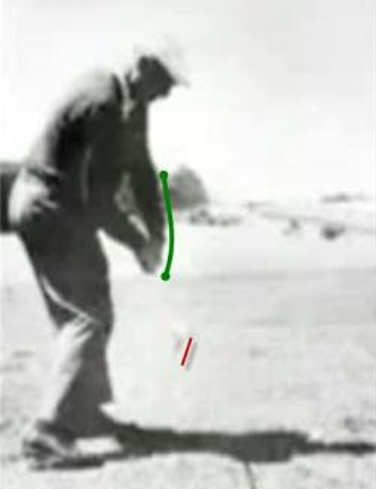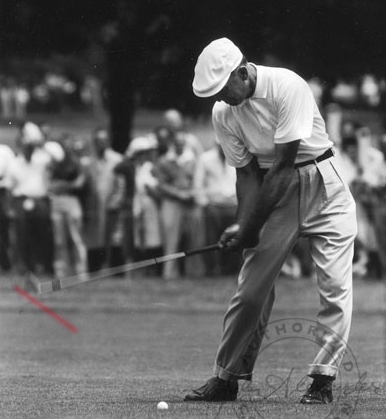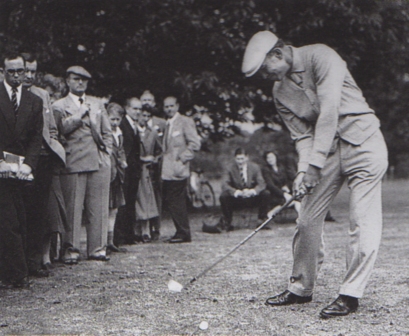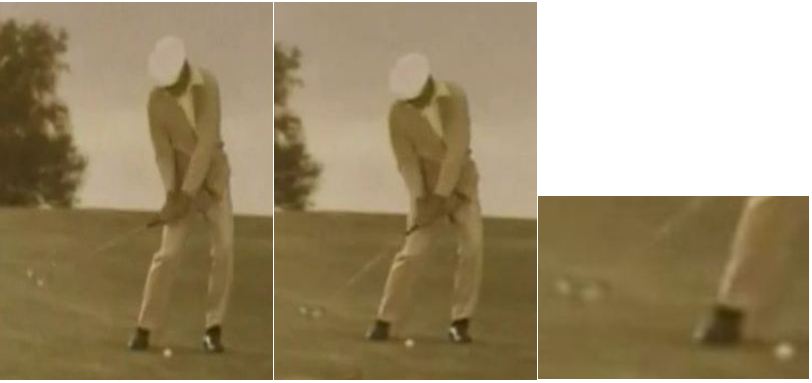Not sure I have ever seen Hogan come OTT on any shot or swing. Shut face coming down is not what he was doing either. Hogan’s forearm rotation assured he had the clubface open coming down so he could rotate properly and stay aggressive.
Indeed his handpath and left arm are shifting closer to the baseline, but thru the slotting his sweetspot goes early to
the delivery path… (reverse downloop, double shift pattern)
[youtube]http://www.youtube.com/watch?v=9O7W9hvo7KQ[/youtube]
Squaring the club face early depends what you define as early…


Would be interesting to know what ballflight he had in the following pic:

Chris
Chris has demonstrated exactly what I mean.
Just want to share my favourite footage in HD…
[youtube]http://www.youtube.com/watch?v=jHHtHVUinjc[/youtube]
It is only in 960 x 720, but it looks in fullscreen ( Quality 720p HD) on my monitor quite good.
Thoughts… not necessary.
Chris

As far as the steepness… it appears the camera was set up possibly near the ground or shoebox level and close to him and well off the target line which may give the illusion of it being above the elbow.

Basing a swing theory on one photo for one’s convenience is not wise methodology. That one photo is not his clubface. Hard to know what he might have been doing or demonstrating.
You would need to successfully explain away all the hundreds of DTL P3 captures of Hogan with the shaft deep low into the right hip pocket with the clubface still wide open, particularly in competition where we can eliminate that he was showing something such as what not to do.
You also have to take into consideration the various camera angles… but if if you view enough of them… you get the idea. Hogan was not steep coming down… nor was his face shut… nor did he ever suggest that feeling in a book or film demonstration such as the Coleman vid.
Curious about the steep - shut wormhole? Proceed with caution.
I admire your patience Lag.
I would not have held back
Steve
That is a little uncalled for. The more open discussion and varied opinions we have about golf swing theory the more we can all learn.
Taking an ABS evangelistic approach to the golf swing isnt very helpful in an open forum.
Im all for open discussion. I was not being critical, just admiring Lags patience.
Lag could easily have written a book refuting Hogan being closed at P3 and supplied 1000’s of photos to support his view. He didnt. So i admired his patience.
Steve
Are you defining early as P3 and anything else is not early?
As chris said, it depends very much on what you call early.
To me, in the downswing, the post accident Hogan moves the club from behind him, where the clubface is open to his arc, to in front of him, with the clubface square to the arc of his swing well before impact. From that point he simply needs to continue with the rotation of his body and swing of his arms to hit the ball squarely. Another way of saying it would be that he is not in a “stuck” position after the club comes in front of him which would require a flip in order to square the club face at or near impact (more like the Hogan that didn’t win tournaments). His impact was repeatable because he did not have a rapid rate of clubface closure or “squaring” at or very near impact. If you believe he closed the club face late, at or near impact, please show me videos and photos with the clubface wide open a few inches prior to impact.

I suggest, that Hogan, along with all other great strikers, detested the face closing prior to impact, and tried with all their might to keep it facing the target post impact.
A stall and flipper Hogan was not, nor is it what we learn at ABS.
Ive not seen any footage where i can see Hogans clubface so clearly 3 inches from impact, but i would bet my last dollar, it still be slightly open. Happy to be wrong, i am here to learn.
Steve
Im not suggesting, and im sure ur not, that Hogan held it open to the last split second and flicked it to square it up. U will see that move on tv plenty these days.
Steve
Hard to find much video that is really clear…and photos likewise because of poor shutter speed etc when compared to the past 30 years or so…
I think that photo that keywester posted is from Jules Alexander collection which were taken at Westchester CC in New York around 1970 in Hogan’s final appearance on the PGA…so I am sure he wasn’t as finely tuned a golfer at that stage because of his age…
This photo from 1953 at Wentworth in England and is quite clear and shows the face still open to some degree quite close to impact…and probably a much better vintage of swing to look at
Plus we need to be careful about shot shape when we look at many photos and/or videos…Hogan didn’t tend to aim too differently and made adjustments for draws and fades with the motion more than his alignment…

Here’s another…again still hard to see perfectly but you can see the ferrule and the face and work it out

Nice pics Two
Here is Nfbandon’s recent action he sent me this morning. I think it is relevant to the discussion. We can see how open the face is at P3, and how quick and powerful the torso rotates level to square up the face. I often hear arguments that tall players must be forced into upright gear, but I think NF is about 6-4 and working a pretty flat shaft into impact as Hogan did.
We have been working on lowering his COG by adding more knee flex into impact.
The general action of Hogan isn’t a big mystery. He worked the shaft from flat and open at P3 into impact via aggressive torso and forearm rotation. NF’s clubface is not flipping over post impact because of the accelerating torso action. It’s still pressuring the club post impact pinning the face open with force and pressure. There is no stall going on here.
This isn’t about positions, it’s about dynamic motion. The video of this swing in full speed looked excellent. You can’t contrive or pose these positions and expect good results. Notice how fast the shoulders have turned from impact to the next frame.
Hogan’s shoulders would typically be a bit more open at impact, but not more open at P3. This is because Hogan had incredible torso rotational acceleration through and post impact even into his finish. This is why I really drill module 3 as much as possible… because the better you do that… the better you are going to compress the golf ball. The more inner the strike becomes. This is exactly why the golf swings from the last generation are far superior to what we typically see in most of today’s pro swings.
NIce work and work ethic, Grady, and it gets me pumped to work harder. Also kudos to your patience on that other site where it’s never good enough (nor should it be, I guess) but honestly…some poetic license here, but things like…‘nice swing, but can you hit a five yard draw standing on one leg, no? then not Hogan.’ I fully expect a comment soon from some yahoo along the lines that ‘until you’ve been t-boned by a bus on a foggy Texas highway and have to wrap your legs in bandages, not Hogan!’
Keep on keepin’ on brother.
Regarding square vs. open:
We need to standardize our language and simplify things here…
At what point do you think Hogan squares the face to the arc?
At what point do you think Hogan squares the face to the target?
Maybe this vid will help:
[youtube]http://www.youtube.com/watch?v=G4DCZuAj5Mg[/youtube]
You’ll have to use his hand as a surrogate for the clubface since it drops out of view
Paul C.
Ha…they are already after me over there. The guy that really gets me though is Doug. Read his latest “response” to Bradley. The guy is delusional. There is really no point in responding to him,but his posts are so irritating you are almost compelled to do so. His earlier post that he could really help Luke Donald was hilarious as well.
Talking about Hogan is a great topic. The problem is that no one hits like Hogan, so there is always some degree of speculation.
I’ve been working on some new tests and simple scientific experiments in the last few months regarding shaft flex particularly into the woods.
It’s been common acceptance from very early in the history of the game… right into today, that you should have different shafts in your woods.
Why?
I spoke last week again to Ron Chalmers who ran Precision shaft company, and Brunswick. Precision made the shafts for Hogan. The Apex shaft was a custom Precision shaft.
Ron knew exactly where I was going with this… and then immediately brought up Hogan and how he had his shafts in his woods. They were different… It makes perfect sense to me… and I played today with the stiffest steel driver shaft I have ever played by a mile. I actually had to construct it out of three separate pieces of steel shaft epoxied together. It looks like something out of a Mad Max movie. I won’t go into a play by play, but I hit 17 greens today at Mare (personal best). I would say it is very interesting. The science behind it is interesting, but I feel much better after field testing it.
Now, there are countless accounts of Hogan’s personal sets having telephone poles in them. Anyone I have read that actually held his personal play sets has described them as such. Telephone poles, tree trunks, felt like solid steel rods…
that sort of thing.
Heavy heads for sure… and very flat, and no offset.
Now anyone that thinks that the gear you use is not going to affect the way you swing a club doesn’t understand the development of a golf swing very well.
Heavy heads and stiff shafts are a good match. Flat lie angles is a well kept secret.
If you are not seriously discussing these gear factors when discussing Hogan, then you might as well just shut down the thread as far as I’m concerned. Hogan knew this stuff. He applied it… and demonstrated it for all to see. Is seeing believing? For many, the answer is yes. Those who saw it believe it.
Now, there are all kinds of armchair Hogan experts who think they have it figured out. But if this is the case, then they should have a golf swing that is very similar dynamically, and they should not be hooking the golf ball.
Once you have the gear set up… then we need to see a few basics in the swing particularly at transition, P3, P4 and PV5.
To enter the Hogan conversation with any degree of credibility, you need to have the shaft flattening at transition. There is a way to do this… to learn this… but if you are not doing this… then you are not into Hogan territory.
Second, you need to slot the club across the chi line at P3. That shaft needs to be flat, open and feeding out of the right hip pocket.
So we on occasion see someone do this.
HOWEVER… can you take that flat, laid off load, and rip that shaft hard left post impact without pivot stalling and dumping the shaft out to right field with a ton of clubface rotation? Most "experts"never get this move. This is something that you really have to feel… and there is only one way to do it. You have to pick up the acceleration rate of the torso and hit hard with the hands and forearm rotation. If you can do this… and hold shaft flex… now we are talking.
Then you need to finish it off with a left shoulder that keep moving right to finish that keeps the rotation ahead of the shaft so that the clubshaft doesn’t flip up to quickly past P4. That structure needs to be there right to the finish. That look comes much easier with a swinger’s release out to right field. Let’s see a guy cut it left hard and do that with a driver. This is where I see Hogan was unmatched by anyone ever.
So to recap, once you have flat, super stiff heavy gear then:
- Slot at transition
- Hit the chi line at P3
- Hold shaft flex through impact.
- Cut it left hard with torso rotation pressured against the right foot while preserving right arm flex to inhibit clubface rotation post impact.
- Hit the skyward vertical clubshaft at PV5 with a left side torso crunch.
Then… we are seriously talking Hogan concepts.
All the grip discussions, stance, backswing etc… are fine, but if they are not directly related to these core dynamic functions
then you might as well be talking about some other pro’s golf swing.




